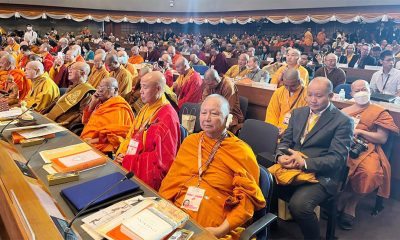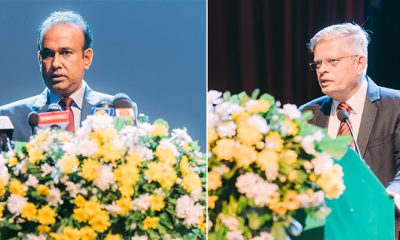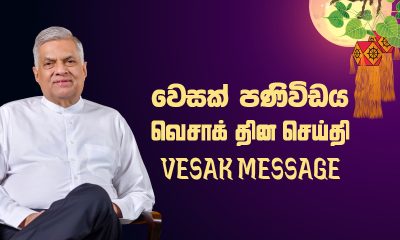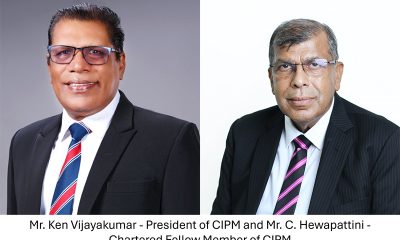Midweek Review
Climbing to a High

By Lynn Ockersz
There it gawkily stands,
First among skyscrapers,
Rising over teeming slums,
Inspiring not a sense of awe,
But speaking volumes,
Of the Arrogance of Power,
And giving thwarted humans,
An opening to an opiate,
That injects a fleeting sense,
Of rising above mortal wants.
Midweek Review
Post-war deceptions
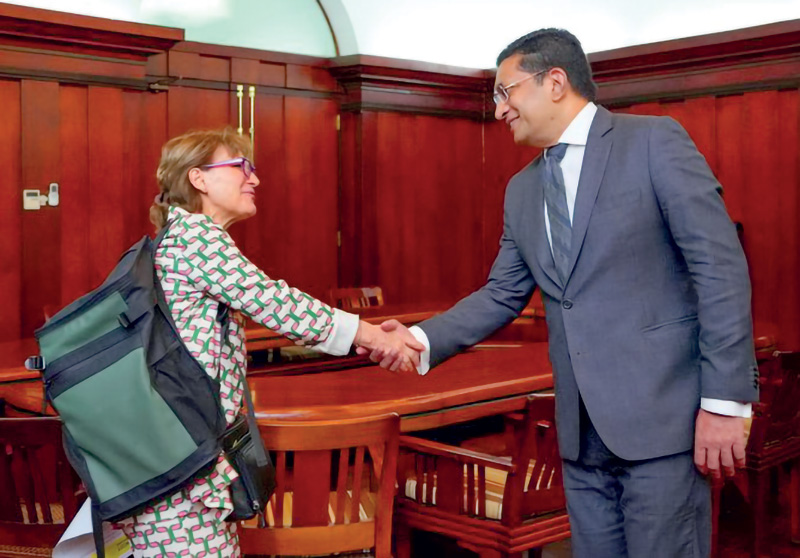
Fifteen years after the eradication of the LTTE, unsubstantiated allegations regarding the number of dead civilians, LTTEers and missing persons persist. Forced disappearances, as alleged by the UN, remains a major issue, with the concerned demanding accountability on the part of Sri Lanka. How many of those who had been categorized as missing are living overseas, under different identities, with passports issued from various countries. Unfortunately, the powers that be seemed to be wholly incapable of building Sri Lanka’s defence. For one and half decades, they shirked their responsibilities. Shame on this lot.
By Shamindra Ferdinando
Parliamentarian Akilan Manoharan Ganesan found fault with the US-led Western powers, successive post-war governments and one-time LTTE mouthpiece, the Tamil National Alliance (TNA) for what he terms the continuing predicament of the Tamil community.
In a statement tweeted on the eve of the 15th anniversary of the conclusion of the war, the former Yahapalana Minister alleged (1) the international community gave Sri Lanka the go ahead for all-out war against the LTTE (2) Sri Lanka ordered the closure of the Vanni Office of the UN to pave the way for war without witnesses (3) international community failed to ensure a political solution nor address accountability issues, as promised (4) Western powers arranged ‘honeymoon’ between Sri Lanka and TNA (5) Tamil community not allowed to commemorate the war dead (6) President Ranil Wickremesinghe response to Tamils’ concerns and grievances questionable (7) UN failed to ensure the Tamils’ right to commemorate war dead and (8) the failure on the part of the US to convince/compel Sri Lanka to address Tamils’ grievances.
MP Ganesan shared the tweet with his leader Sajith Premadasa and Anura Kumara Dissanayake, the leader of the JVP-led Jathika Jana Balawegaya (JJB). Interestingly, when the UNP backed retired war-winning General Sarath Fonseka’s candidature at the 2010 presidential poll, Mano Ganesan’s party was in that coalition, consisting of the UNP, TNA, JVP and SLMC.
Lawmaker Ganesan chided outgoing US Ambassador Julie Chung for the US inaction, despite all of her interferences here, especially in regard to the success of the violent protest movement that ousted the duly elected President Gotabaya Rajapaksa. She conveniently called them peaceful protesters and prevailed on the military and police not to take any action against them. Chung’s successor Elizabeth Horst has already caused controversy by declaring that Sri Lanka imposed a one-year-ban on the entry of foreign research vessels into our waters at their behest. Appearing before the powerful Senate Foreign Relations Committee, Horst has stressed the need for the ban that came into effect on January 1, 2024. The US move, made in consultation with New Delhi, is meant to block visits by Chinese naval vessels.
Let us get back to the issue of post-war consensus among the communities on political solutions, the status of the accountability process and foreign interventions.
Sometimes foreign interventions made for strategic reasons (US interventions here are meant to counter Chinese influence, appease India and influence Tamil community) can be quite devastating. So-called bipartisan US resolution that had been introduced to the US Congress calling on the United States to work towards an independence referendum for Eelam Tamils and recognize the ‘genocide committed against them’ by the Sri Lankan state revealed the superpower’s evil machinations here not having learnt any lessons from their vicious plots executed almost world over. They should at least now open their eyes to the calamity they have created in Palestine by their imperialist plots.
If the US is so sincere in its intentions why not it first create an independent nation for the natives of that country, virtually wiped out by numerous acts of genocide committed by white settlers to grab their land. The few natives who survived such pogroms are still more or less confined to reservations created by white colonialists in most hostile environments. As retribution, the world must demand that the US creates native independent states right across the country for each surviving decimated native tribe.
The same goes for Canada which had been found guilty of killing more than 2000 native children, forcefully boarded at Church run schools there, till themid-1990s to make them assimilate into the white man’s world. The victims’ bodies were found buried in unmarked graves in the precincts of those schools.
The circumstances the resolution compared the Sri Lankan situation to that of South Sudan, Montenegro, East Timor, Bosnia, Eritrea, and Kosovo where independence referendums had been held with support from the United States and other countries are a mystery
Parliamentarians, who represent the Tamil community, not only in the Northern and Eastern Provinces, but the Up country region as well, should state their position on the US proposal. The UNP reduced to just one National List seat in Parliament, the main Opposition party the SJB, largest single group in Parliament, the SLPP, and the new darlings of the West, the JVP, too, should reveal their position.
The US-based Tamil Diaspora seems to be working overtime and appeared to have taken the lead in a high profile campaign to carve out a separate state in the Northern and Eastern Provinces. Their task has been made easier by an utterly corrupt and treacherous political party system, hell-bent on advancing personal agendas even at the expense of the country’s unitary status.
Lawmaker Ganesan’s hard-hitting tweet must have surprised Western embassies. Or did Ganesan just fire the first shot for a fresh round of ethnic chaos here with a wink from the evil West, whose hands are tainted with so much innocent blood from across the globe. However, the not so young politician conveniently left out any reference to India, whose leadership cannot absolve itself of responsibility for the consequences of the war here that she laid the foundation for. The death and destruction caused by India, in Sri Lanka, in the ’80s, and the revenge assassination of former Indian Prime Minister Rajiv Gandhi, in May 1991, by an LTTE suicide bomber, underscored their overall involvement here.
Perhaps, MP Ganesan should consider commenting on the origins of the war as well. The accountability issue cannot be discussed, leaving out India, as she lost nearly 1,500 military personnel fighting the LTTE (July 1987-March 1990).
Having entered the Colombo Municipal Council, in 1999, on the People’s Front ticket, Ganesan successfully contested the Colombo District at the 2001 General Election on the UNP ticket. He was re-elected at the 2004 General Election on the UNP-led UNF ticket. At the 2010 General Election, he moved from Colombo to Kandy but failed to retain his seat. In the following year, he was back at the CMC after successfully contesting the 2011 Local Government polls on the Democratic People’s Front (DPF) ticket. At the Provincial Council polls held in 2014, he was elected to the Western Provincial Council as a DPF member.
The 2015 General Election marked a significant change in Ganesan’s political life when the Yahapalana leadership granted him a newly created National Dialogue portfolio. In the wake of the UNP split in 2019/2020, following the 2019 presidential election, Ganesan switched his allegiance to the Leader of the breakaway UNP faction, the Samagi Jana Balawegaya, Sajith Premadasa. The outspoken politician contested the last parliamentary poll on the Premadasa–led SJB ticket and was elected from the Colombo district. The war-winning Army Chief is the Chairman of the SJB.
Ganesan leads the DPF (Democratic People’s Front, originally Western People’s Front founded in 2000 to represent the interests of Tamils of Indian origin living in Colombo and its suburbs).
At the onset of the Yahapalana administration, Ganesan played a significant role in establishing the Tamil Progressive Alliance (TPA). In his capacity as the DPF leader, Mano heads the TPA, comprising the National Union of Workers and the Up-country People’s Front.
However, the TPA seems to be sharply divided over political strategy as the country heads for the next presidential poll. At the recently concluded May Day celebrations, TPA’s Palani Digambaram appeared on stage with Sajith Premadasa, at Thalawakelle, whereas Ganesan joined the TNA May Day show in Kilinochchi.
War without witness
It was nothing but a blatant lie that Colombo District lawmaker Ganesan uttered in his statement that Sri Lanka received the blessings of the international community to conduct a war without witnesses. Let me discuss the MP’s allegation, taking into consideration the Report of the UNSG’s Panel of Experts on Accountability in Sri Lanka.
During high intensity battles in the Vanni east, the only permanent hospital functioning in that region was at Puthukkudiyiruppu. Regardless of government denials, that hospital had been hit repeatedly by SLA artillery, including Multi Barrel Rocket Launchers (MBRLs) during the January 29-Feb 04, 2009 period. There is absolutely no point in denying that fact.
According to the UNSG’s report that had been officially released on March 31, 2011, the SLA granted UN international staff access to the hospital damaged due to attacks during January 29-Feb 4, 2009. The report also disclosed that there had been two ICRC international members at the hospital when it was hit on February 04 (Paragraph 91).
Therefore, there is no basis for MP Ganesan’s malicious claim that Sri Lanka conducted a war without witnesses. The UNSG’s report also acknowledged that LTTE cadres who had been wounded in fighting in nearby frontline were brought to Puthukkudiyiruppu hospital where the organization maintained a ward for them. (Paragraph 94).
As the SLA further advanced into LTTE-held territory, the ICRC international staff that had been in Puthumathalan throughout the offensive were evacuated by ship flying the ICRC flag on February 10, 2009. Although Sri Lanka didn’t allow UN international staff on that vessel. ICRC ships evacuated thousands of wounded civilians, beginning February 10, 2009 till May 09, 2009, the last voyage before the conclusion of the war. But on 16 occasions, ICRC flagged ships arrived at Puthumathalan during this period, ICRC international staff were allowed to return to Puthumathalan each time the vessels came.
The writer was one of the few journalists allowed to observe the movement from a SLN Fast Attack Craft (FAC) positioned off the Puthumathalan coast in the last week of April 2009 and then visited Pulmoddai where the wounded were handed over to the Indian medical team, based there.
The UNSG report admitted that altogether 2,350 metric tons of food had been delivered to Mullivaikkal, from February 10, 2009 to May 09, 2009 and 14,000 wounded civilians and their relatives evacuated during this period (Paragraph 108).
The ICRC made a bid to bring in supplies and evacuate the wounded on May 15, 2009, but couldn’t do so due to heavy fighting. The bottom line is that the ICRC had access to Puthumathalan till May 09, 2009, just 10 days before the SLA killed LTTE leader Velupillai Prabhakaran.
The bottom line is that the ICRC remained in Vanni east till late January, though the UN pulled out of Kilinochchi in Sept 2008. However, UNSG report admitted that UN international staff were allowed entry to the Puthukkudiyiruppu hospital, following the January 29-Feb 4, 2009 ,artillery barrage.
The international community never gave Sri Lanka the go ahead for an all-out war in 2006. In fact, Western powers constantly put pressure on Sri Lanka to continue negotiations, regardless of grave provocations by LTTE terrorists. There couldn’t be a better example than the assassination of Foreign Minister Lakshman Kadirgamar, at his Bullers Lane residence, in August 2005. The assassination had been carried out just four months before the presidential poll, regardless of the Norway arranged Ceasefire Agreement (CFA) that was meant to destabilize the country.
Western powers, Japan and the UNSC asked the government to continue with the CFA. In April 2006 an abortive bid was made to assassinate Army Commander Lt. Gen. Sarath Fonseka. In early Oct, the same year, another abortive suicide attack was mounted on Defence Secretary Gotabaya Rajapaksa. In January, 2007, the LTTE blasted FAC, off Trincomalee, killing the SLN crew on board. When the LTTE was behaving as if it was on top of the world, none of those shedding crocodile tears bothered at least to issue a statement requesting the LTTE not to escalate chaos. Then in late July 2006, the LTTE closed down the sluice gates of Mavil-aru, depriving the people downstream of water. In the second week of August 2006, the LTTE declared Eelam War IV with simultaneous attacks on the SLA’s northern frontline and in the East. The rest is history.
Western powers and India never believed that the Sri Lankan military had the wherewithal to bring the war to a successful conclusion. In the wake of a relentless ground offensive, backed by strategic air and naval strikes, in addition to operations carried out in support of the advancing troops, the LTTE retreated on all fronts until they were trapped in Mullaithivu. Once considered to be invincible, the LTTE collapsed within two years and 10 months 15 years ago.
Turning a blind eye to post-war developments
Those who couldn’t stomach eradication of conventional fighting capability of the LTTE continued to find fault with Sri Lanka for various post-war shortcomings. Unfortunately, successive governments haven’t done enough to convince the people and the global community of successful handling of post-war developments.
Sri Lanka can quite rightly be proud of the way over 12,000 LTTE combatants at all levels, including hardcore cadres, were integrated back into the society. The International Organization for Migration (IOM), with the support of the international community, including the UK, the US, Norway, Japan and Australia, implemented quite a successful project to reintegrate them to civilian life, following rehabilitation under military supervision.
The Tamil Diaspora, or Tamil political parties represented in Parliament, never wanted to support that project. They played politics until the government and the IOM brought that project to a successful completion. Tamil Diaspora and Tamil political parties never acknowledged that over 12,000 terrorists were released without being produced in court. They never appreciated the gradual release of land held by the military during the war. Instead, they propagated lies. One of the most blatant lies was the declaration that 104 LTTE cadres, held by the SLA, were poisoned to death. The claim was made by the then Northern Province Chief Minister C.V. Wigneswaran, his TNA colleagues and a section of the Tamil media.
Retired justice Wigneswaran had no qualms in involving the US by requesting their intervention to conduct medical examination whereas international media gave ample coverage to the TNA lie.
Headline in the Madras-based Hindu online edition of August 18, 2016, updated on Nov 17, 2021, screamed ‘104 LTTE cadres poisoned to death at Sri Lanka rehab centres’ with strap line ‘Startling accusation by Tamil politicians who say the surviving ex-combatants had claimed physical disability as a result’
Wigneswaran went to the extent of seeking the then US Ambassador Atul Keshap’s intervention. Finally, Wigneswaran ended up with egg on his face but that didn’t prevent him from entering Parliament on Thamil Makkal Theshiya Kutani (TMTK), a newly formed political party.
Obviously, Tamil political parties and the Tamil Diaspora never expected Sri Lanka to reintegrate thousands of LTTE cadres, detained during the final offensive, to be rehabilitated and released within a few years.
Then they unleashed a far bigger lie when the SLA was accused of killing and burying thousands in Manner mass graves. The then UN human rights Chief Michelle Bachelet held Sri Lanka accountable. But a US lab revealed that the bones found therein were several centuries old and belonged to the colonial period.
The radiocarbon dating analysis by the Beta Analytic Testing Laboratory in Florida, US, in respect of six skeletal samples sent there in January 2019 determined scientifically that the skeletons belonged to a period that covered the Portuguese and the Dutch rule here. The UN never bothered to verify facts. The global body was in an indecent hurry to heap up pressure on war-winning Sri Lanka.
The following is the relevant section bearing No 23 from Bachelet’s report: “On May 29, 2018, human skeletal remains were discovered at a construction site in Mannar (Northern Province), Excavations conducted in support of the Office on Missing Persons, revealed a mass grave from which more than 300 skeletons were discovered. It was the second mass grave found in Mannar following the discovery of a site in 2014. Given that other mass graves might be expected to be found in the future, systematic access to grave sites by the Office as an observer is crucial for it to fully discharge its mandate, particularly with regard to the investigation and identification of remains, it is imperative that the proposed reforms on the law relating to inquests, and relevant protocols to operationalize the law be adopted. The capacity of the forensic sector must also be strengthened, including in areas of forensic anthropology, forensic archeology and genetics, and its coordination with the Office of Missing Persons must be ensured.” The Bachelet report dealt with the situation here from Oct 2015 to January 2019.
If the LTTE hadn’t been eradicated 15 years ago how many more children could have perished in the war? The LTTE mercilessly used child soldiers in high intensity battles in the northern theatre until the very end. Had Sri Lanka been allowed to finish off the LTTE at an earlier stage lives of thousands could have been saved. Had that happened, the war could have been fought to a finish somewhere else not at Nanthikadal from where Prabhakaran was sent to the netherworld.
Midweek Review
Record changes in society
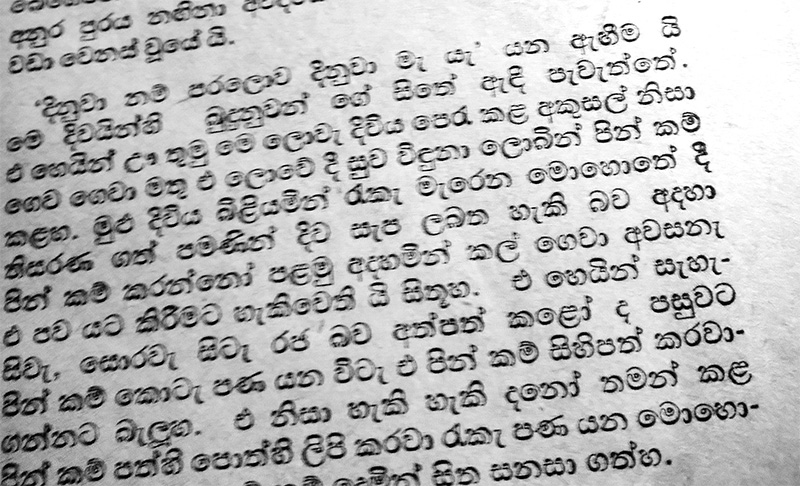
By Usvatte-aratchi
‘…For, numerous as have been the autobiographies of the past, almost all have come from the upper or middle class, and most recent ones of distinction (…..) have a public-school background. There are very few autobiographies that come out of the working class and reveal its ways of behaviour and feeling from within, its standards and reflections upon itself. And it is curious, since the war of 1914-1918 a whole generation has come up in the normal course from elementary and secondary school to the university, forming almost a new middle class, that not a single autobiography has yet (March 1942) appeared, so far as I know, which gives any account of that process of education and emergence, though it has become the more usual one for the nation at large. I cannot claim that the story told in this book is necessarily typical, yet I have some hope that, when complete, it may be regarded as representative of its generation.’
– A.L. Rowes, Fellow of All Souls, FBA.
I have lived in a society that has undergone massive changes. If you recall life in the 1950s when I was 15 to 25 years old and compare that with what goes on in the 2020s, (a good 70 years later) you will observe changes all around you. I am not speaking about the foul rot in political life, talking about which I am sick to the core. Since 1950-1960, there have been upheavals in most aspects of this society and they have gone mostly unrecorded at the micro-level. There are a few landmarks of record. An early landmark was The Disintegrating Village written by Sarkar and Tambiah, based on a survey of five villages in Pata Dumbara (I was a student who worked on the Survey.). They were interested mostly in economic, especially, agrarian relations. There were, in quick succession, Gananath Obeysekera’s Land Tenure in Village Ceylon, Edmond Leach’s Pul Eliya, and several pieces of work by Obeysekera and by Richard Gombrige. These latter works, outstandingly good as they are, gave us static pictures. That was the nature of anthropological inquiry. Malinowsky spent about six years travelling to Trobriand Islands off New Guinea and wrote up what he observed. That was anthropology then. There are official surveys of the living conditions of the people at large. The best known in our country are the Consumer Finance Surveys carried out by the Research Department of the Central Bank of Ceylon (later Sri Lanka) from 1952, under the direction of Theodore Morgan. Latterly these have been replaced with Surveys of Living Conditions carried out by the Department of Census and Statistics of the government. In addition, there are whole sets of statistical information generated by the Registrar-General, the Director of Medical Services (DM&SS), the Department/Ministry of Education and the University Grants Commission.
Collating and analysing them is tedious, as it would need reading a lot of data. If one makes use of these data with imagination, it is possible to arrive at some understanding of the nature of changes that have taken place in our society during the last 70 years or so. Yet the pictures you arrive at will remain static. You do not have so many pictures which when made to move fast one after the other to create the illusion of movement, as we enjoy when we see a movie. We do not see society on the move and that is what I am after.
In contrast, social change comes out of dynamic processes in society. You can see them most spectacularly in the French Revolution of 1789 and beyond and the Bolshevik Revolution in October 1917. Whole layers of society were either laid waste or thrown off their perches to be replaced with newcomers, performing the same essential functions in very different ways. In many societies, changes have been gradual, though not necessarily less spectacular, Charles 111 in England is a very different ruler from Charles 11 who in 1662 gave a charter to the Royal Society. It is this slow-moving dynamism of our society that I find poorly documented.
M.N.Srinivas, in a justly famous lecture in California, provided an excellent framework within which some social changes in India could be studied. Changes in our society are far less spectacular, though no less thoroughgoing. Martin Wickremasinghe’s celebrated essay on Bamunukulaya Binda Vateema stands out as useful but a one-shot exercise that did not lend itself to analyzing dynamic processes. Wickremasinghe’s celebrated novel Gamperaliya and Kumari Jayawardene’s biography of her father A.P.de Zoyza are essays on the commercialization of the village and not the vertical mobility of a person vertically in the income scale..
To pick up a metaphor highly imaginatively used in a TV drama on BBC (and later PBS) over a number of months, my interest is not in those who live ‘Upstairs’ or ‘Downstairs’ but the latter who climb the stairs to live ‘Upstairs’. I am interested in the foundations on which the stairways had been built and the nature of the stairs as well. I am not interested in those in the ‘middle or upper classes’ but about those in the ‘working classes’, although those classifications do not make much sense in our society. I am interested in those unlettered and propertyless, who climbed out of those gruesome lives to be lettered and to sleep on a bed in a home that did not leak when it rained and let in some air when the front door was shut. Some of them, as it happened, went beyond. There was that boy from Nugawela Central School, who became not only a highly respected civil engineer but also the leader of a political movement, that boy from Ibbagamuva Central School who became a world-class historian and the vice-chancellor of his university, that girl from Meepavala, Poddala, who was an expert teacher of English in Nigeria and the head of the leading girls’ school in the Maldives. There were (perhaps) millions more.
And their stories have not been told.
This is where A.L.Rowse’s A Cornish Childhood comes in. Rowes lived in Tregonissey, a village in Cornwall. His father and uncles were miners. They had been to South Africa to work and their world was wider, much wider, than that of a boy in a village in Morawakkorale in the south of Ceylon. When Rowe went to primary school, he ‘could not understand why little boys didn’t like attending school’. I was moved up the school at a very rapid rate, sometimes jumping a whole standard altogether.’ ‘ … there were no books to read at home, not a single one’. ‘By quick promotions, I had arrived at the top of the school by the time I was eleven. ‘ I had not only got a scholarship but was placed first in the district..’. I never had been out of Cornwall until at the age of seventeen I went to Oxford to try a scholarship. Rouse wanted 200 pounds to go to Oxford and had to win scholarships giving those funds. He won 60 pounds from a county scholarship….
There was an English scholarship to be offered at Balliol. But what chance was there of my winning a Balliol scholarship, I asked…., Rowes won a scholarship in English to Crist Church.
He now had 140 pounds, still short by 60 pounds. Drapers Company, in response to a recommendation by Rowse’s old headmaster Jenkins, offered him the 60 pounds that enabled him to go to Christ Church in Oxford. Rowse was elected a fellow of All Souls College at the age of 21 years. And he became a brilliant historian of the Elizabethan age. Later he was elected to Parliament from the Labour Party.
Writing autobiographies or even biographies is not a feature of our culture. Rapiel Tennakoon, brilliant scholar, a prolific poet and a master of sarcasm in the mid-20th century, sought the sources from which Mahavamsa may have been written. He found that a very important source was pinpoth maintained by powerful people like kings, queens, ministers and rich persons. They kept records of meritorious deeds performed by them and were sometimes read aloud when the doers were on death bed. These did not amount to autobiographies or biographies.
Wickremasinghe and Sarachchandra both wrote highly readable autobiographies but they lie outside my period of interest. Besides, they contain much literary history, which is not of present interest to me . A.T. Ariyaratne, who died recently, left an autobiography running into three volumes.
He did not start quite from the bottom but climbed great heights. Sarath Amunugama has written an excellent autobiography, still to be completed, but he started from ‘upstairs’, climbing further with great ease and grace.
It is Rowse-kind of autobiography that I want. I tried my hand and wrote that novel Alut Matanga. As a kindly friend remarked, it was a thinly veiled autobiography. He was perfectly right. And so I wrote in the preface. I could not find a way of writing an autobiography without embarrassing and even offending a mass of persons who had supplied the steps on which I went to secondary schools, Peradeniya and eventually to Cambridge. It was a reality that neither my family nor my primary school teachers had imagined, though they let me skip a whole year of schooling. The public stairway for me to climb ‘upstairs’ had been designed by C.W.W. Kannangara, A Ratnayake, V Nalliah and J.R. Jayewardene. The stairs had been kept in place with fuel supplied by the taxpayers of this society. It is that climb ‘upstairs, that I wanted documented. An analysis of such journeys will explain much of what happened in our society from about 1990 when persons who rose from ‘downstairs’ took control of affairs ‘upstairs’.
Midweek Review
Form and Substance
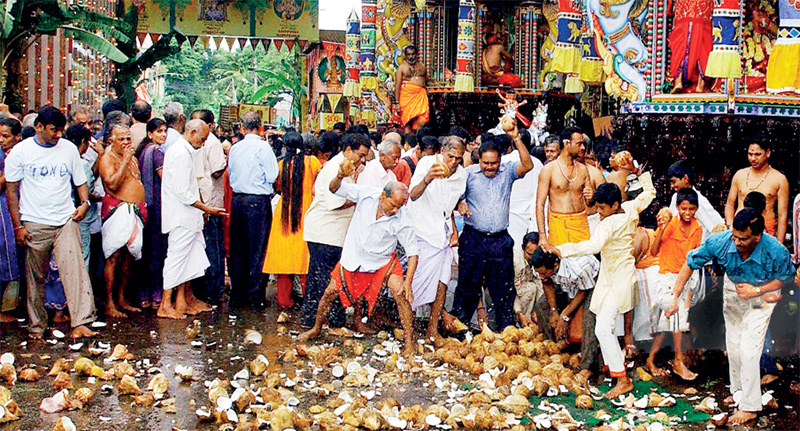
By Lynn Ockersz
After the frenzied dashing,
And the wild calls for revenge,
Milky-white pieces of kernel,
The rich core of the coconut,
Evoking the starry heavens,
Lie across the pained earth,
Recalling a mindlessness,
That sacrifices substance,
For the form’s wilting husk;
That so easily gives up,
The best parts of religion,
For its orchestrated rituals.
-

 News7 days ago
News7 days ago73 countries attend UN International Vesak Day 2024 in Thailand
-

 Business4 days ago
Business4 days agoThree contenders shortlisted for acquisition of ailing SriLankan Airlines
-

 Business5 days ago
Business5 days agoUnilever – Lever Ayush strengthens commitment to traditional medicine as Main Sponsor of International Research Symposium at AyurEx Colombo 2024
-

 Business7 days ago
Business7 days agoSri Lankan ambassador to Viet Nam in warm discussion with leading Southeast Asian EV manufacturer
-

 News4 days ago
News4 days agoAll Sri Lankan’s must unite irrespective of race, religion, caste or political affiliation to heal and rebuild our country – President
-

 Business7 days ago
Business7 days agoCIPM Great HR Debate 2024 to be held alongside the National HR Conference
-

 Business2 days ago
Business2 days agoDSI Tyres hosts Hankook Tyre Dealers’ Gathering at RIU
-

 News5 days ago
News5 days agoFinally, Ranil confirms Prez poll will be held first













